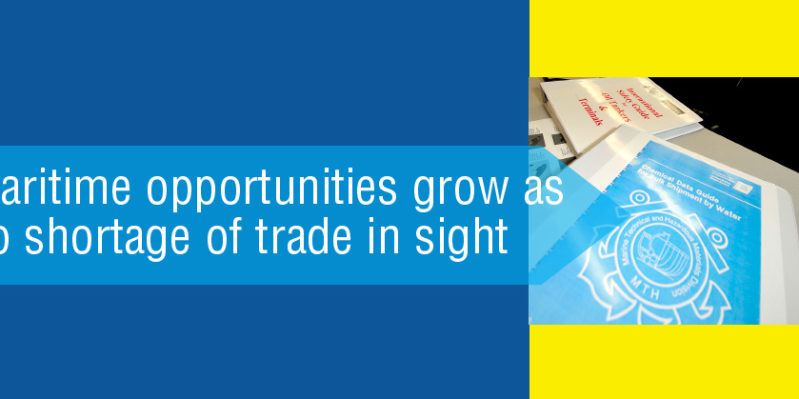
At the age of 52, Dave Allen is ready to earn his degree and sail off to the high seas. He is making it all happen through the San Jacinto College maritime program.
“I have always wanted a college degree, and I have always been interested in maritime,” said Allen. “After 30 years as a successful graphics contractor in Dallas, I researched maritime programs online, and this one fit my goals.”
Allen is studying maritime technology, an associate degree program that is a part of the College’s maritime training that also includes U.S. Coast Guard licensing and certification for professional mariners, and an Associate of Applied Science in International Business, Maritime and Logistics, with partnerships with Texas Southern University and the University of Houston. Students may also pursue maritime administration through an articulation agreement with Texas A&M University at Galveston, following successful completion of a ships and shipping course and associate degree in business administration.
“The industry is certainly facing a shortage, with an aging workforce and the need for more USCG licensed maritime professionals,” said Capt. Mitch Schacter, director of the San Jacinto College maritime program. “What we aim to do is introduce more workers to maritime, while also helping current mariners to move up their career ladders in the industry.”
Allen knows first hand the need of the industry after visiting with several employers before committing to enrollment with the program.
“I have talked to maritime companies, and they tell me that after graduation, I am guaranteed a job,” said Allen. “Since the school is heavily sponsored by the local maritime industry, there is a lot of anticipation and excitement about the graduates coming out of here.”
The total value of marine freight is estimated to increase by 43 percent domestically and 67 percent internationally by 2020, according to the U.S. Department of Transportation (DOT) Maritime Administration. Since 2010, San Jacinto College has awarded approximately 1,800 certificates for USCG-approved training to members of the local maritime industry. Schacter said that approximately 40 USCG-required maritime training courses are offered, which include Basic Safety Training, Tankerman PIC (Person in Charge), RADAR Unlimited, Proficiency in Survival Craft (Lifeboat), and Apprentice Mate – Steersman.
This year, the College will acquire three interactive bridge simulators for professional mariner training thanks to a collaborative agreement with the Houston Pilots. The simulators, valued at approximately $1.5 million, are room-sized replicas of ship control bridges, each with a 270-degree view and life-like graphics displayed on multiple 65-inch monitors. They will come complete with instructor stations, debrief classrooms, and development stations.
Course options, and simulation training, will increase once the College opens a new maritime facility on 13 acres along the Port of Houston in the coming years. Currently, mariners train at the San Jacinto College Maritime and Technical Training Center, equipped with the simulators Liquid Natural Gas (LGN) Transfer, RADAR, CargoMax, Electronic Chart Display Information System, Automatic Radar Plotting Aid, Liquid Cargo Transfer, and a Global Maritime Distress and Safety System.
“Each of those who enrolled in the program come for their own reasons, but most agree that there is something different about working on the water; it is not just a job,” said John Torgersen, maritime technology instructor. “It is not the life for everybody. It is not easy to explain why, but a sailor is all that I ever wanted to be.”
For more information about maritime training at San Jacinto College, visit www.sanjac.edu/maritime.
Jeannie Peng-Armao

